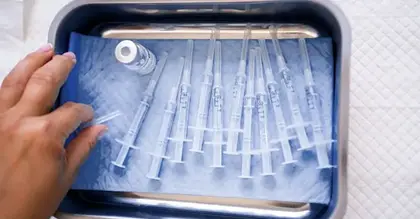Drug Detail:Dactinomycin (Dactinomycin [ dak-tin-oh-mye-sin ])
Drug Class: Antibiotics / antineoplastics
Usual Adult Dose for Wilms' Tumor
As part of a multi-agent combination chemotherapy regimen: 45 mcg/kg IV over 10 to 15 minutes once every 3 to 6 weeks for up to 26 weeks
Use: For the treatment of Wilms tumor as part of a multi-phase combination chemotherapy regimen
Usual Adult Dose for Rhabdomyosarcoma
As part of a multi-agent combination chemotherapy regimen: 15 mcg/kg IV over 10 to 15 minutes once daily for 5 days every 3 to 9 weeks for up to 112 weeks
Use: For the treatment of rhabdomyosarcoma as part of a multi-phase combination chemotherapy regimen
Usual Adult Dose for Ewing's Sarcoma
As part of a multi-agent combination chemotherapy regimen: 1250 mcg/m2 IV over 10 to 15 minutes once every 3 weeks for 51 weeks
Use: For the treatment of Ewing sarcoma as part of a multi-phase combination chemotherapy regimen
Usual Adult Dose for Testicular Cancer
As part of a cisplatin-based multi-agent combination chemotherapy regimen: 1000 mcg/m2 IV over 10 to 15 minutes once every 3 weeks for 12 weeks
Use: For the treatment of metastatic nonseminomatous testicular cancer as part of a multi-phase combination chemotherapy regimen
Usual Adult Dose for Trophoblastic Disease
As a single agent for nonmetastatic and low-risk metastatic disease: 12 mcg/kg IV over 10 to 15 minutes daily for 5 days
As part of a multi-agent combination chemotherapy regimen for high-risk metastatic disease: 500 mcg IV over 10 to 15 minutes Days 1 and 2 every 2 weeks for up to 8 weeks
Use: For the treatment of post-menarchal patients with gestational trophoblastic neoplasia as a single agent or as part of a combination chemotherapy regimen
Usual Adult Dose for Solid Tumors
In combination with melphalan for lower extremity or pelvis: 50 mcg/kg IV over 10 to 15 minutes once
In combination with melphalan for upper extremity: 35 mcg/kg IV once
Use: For the treatment of adult patients with locally recurrent or locoregional solid malignancies as a component of palliative or adjunctive regional perfusion
Usual Pediatric Dose for Wilms' Tumor
As part of a multi-agent combination chemotherapy regimen: 45 mcg/kg IV over 10 to 15 minutes once every 3 to 6 weeks for up to 26 weeks
Use: For the treatment of Wilms tumor as part of a multi-phase combination chemotherapy regimen
Usual Pediatric Dose for Rhabdomyosarcoma
As part of a multi-agent combination chemotherapy regimen: 15 mcg/kg IV over 10 to 15 minutes once daily for 5 days every 3 to 9 weeks for up to 112 weeks
Use: For the treatment of rhabdomyosarcoma as part of a multi-phase combination chemotherapy regimen
Usual Pediatric Dose for Ewing's Sarcoma
As part of a multi-agent combination chemotherapy regimen: 1250 mcg/m2 IV over 10 to 15 minutes once every 3 weeks for 51 weeks
Use: For the treatment of Ewing sarcoma as part of a multi-phase combination chemotherapy regimen
Usual Pediatric Dose for Testicular Cancer
As part of a cisplatin-based multi-agent combination chemotherapy regimen: 1000 mcg/m2 IV over 10 to 15 minutes once every 3 weeks for 12 weeks
Use: For the treatment of metastatic nonseminomatous testicular cancer as part of a multi-phase combination chemotherapy regimen
Usual Pediatric Dose for Trophoblastic Disease
As a single agent for nonmetastatic and low-risk metastatic disease: 12 mcg/kg IV over 10 to 15 minutes daily for 5 days
As part of a multi-agent combination chemotherapy regimen for high-risk metastatic disease: 500 mcg IV over 10 to 15 minutes Days 1 and 2 every 2 weeks for up to 8 weeks
Use: For the treatment of post-menarchal pediatric patients with gestational trophoblastic neoplasia as a single agent or as part of a combination chemotherapy regimen
Renal Dose Adjustments
Renal dysfunction may occur. Monitor creatinine and electrolytes frequently.
Liver Dose Adjustments
Hepatic dysfunction may occur. Monitor creatinine and electrolytes frequently during therapy.
Dose Adjustments
Calculate the dose for obese or edematous patients based on ideal body weight.
Precautions
CONTRAINDICATIONS:
- None
Consult WARNINGS section for additional precautions.
Dialysis
Data not available
Other Comments
Administration advice:
- Administer the diluted reconstituted product IV over 10 to 15 minutes.
- Do not use in-line filters with a cellulose ester membrane.
Storage requirements:
- Store unopened vials at 20C to 25C (68F to 77F). Protect from light and humidity.
- Store at room temperature for no more than 4 hours from reconstitution to completion of infusion. Discard after 4 hours.
- This drug does not contain a preservative; discard any unused portion.
Reconstitution/preparation techniques:
- Reconstitute each vial by adding 1.1 mL of sterile water for injection without preservative using aseptic techniques.
- The reconstituted product should be a clear, gold-colored solution at a concentration of 500 mcg/mL.
- Further dilute the reconstituted product with 5% dextrose injection or 0.9% sodium chloride injection to yield concentrations greater than 10 mcg/mL.
IV compatibility:
- Compatible with sterile water, 5% dextrose injection, and 0.9% sodium chloride injection.
General:
- This drug is cytotoxic; follow applicable special handling and disposal procedures.
- Visually inspect the vials for particulate matter and discoloration whenever solution and container permit.
Monitoring:
- Monitor renal and hepatic function.
- Monitor platelet and white cell counts.




